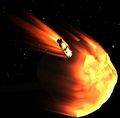Difference between revisions of "Asteroid"
(where to find parts file) |
|||
| Line 2: | Line 2: | ||
An '''asteroid''' is a randomly created [[celestial body]] with sizes between 3 and 30 meters. | An '''asteroid''' is a randomly created [[celestial body]] with sizes between 3 and 30 meters. | ||
| − | This is the first type of celestial body that is not on rails to change their orbits. This means that they can be captured by other bodies or collide with them. The current [[Kerbol System]] is designed to prevent any SOI change which would disturb their orbit. Unlike the other celestial bodies, asteroids are too light to have any gravity. This makes them more like a non-player created [[craft]]. But they need to be discovered and monitored with the [[Tracking Station]]. They come in various classes from class A (tiny) to class E (Huge). Asteroids can be white, black and grey and come in random shapes. | + | This is the first type of celestial body that is not on rails to change their orbits. This means that they can be captured by other bodies or collide with them. The current [[Kerbol System]] is designed to prevent any SOI change which would disturb their orbit. Unlike the other celestial bodies, asteroids are too light to have any gravity. This makes them more like a non-player created [[craft]]. But they need to be discovered and monitored with the [[Tracking Station]]. They come in various classes from class A (tiny) to class E (Huge). Asteroids can be white, black and grey and come in random shapes. Asteroids are parts, as opposed to celestial bodies. The part configuration file which is used as a prototype for each procedurally-generated asteroid can be found in <tt style="white-space:nowrap;">[[GameData]]/NASAmission/Parts/[[Parts/NASAmission/PotatoRoid/part.cfg|PotatoRoid]]/</tt>. |
Asteroids should not be confused with [[captured asteroid]]s, as they are on rails and have gravity. | Asteroids should not be confused with [[captured asteroid]]s, as they are on rails and have gravity. | ||
== Capturing asteroids == | == Capturing asteroids == | ||
| − | + | The update in which asteroids were released is called [[Asteroid Redirect Mission]]. The general notion is to rendezvous with an asteroid and attach to it with an [[Advanced Grabbing Unit]]. The craft can then use its engines to alter the orbit of the asteroid. This can be used to get it into a stable orbit around [[Kerbin]] or another celestial body and even land it. | |
| − | == Science == | + | === Science === |
Currently only samples can be taken from each asteroid yielding 60 [[Science]]. However, different samples can be collected from the same asteroid in different situations, like high orbit, low orbits, atmosphere and even in different biomes when the asteroid is landed on a celestial body. | Currently only samples can be taken from each asteroid yielding 60 [[Science]]. However, different samples can be collected from the same asteroid in different situations, like high orbit, low orbits, atmosphere and even in different biomes when the asteroid is landed on a celestial body. | ||
| − | |||
| − | |||
| − | |||
== Gallery == | == Gallery == | ||
Revision as of 22:07, 6 April 2014
An asteroid is a randomly created celestial body with sizes between 3 and 30 meters.
This is the first type of celestial body that is not on rails to change their orbits. This means that they can be captured by other bodies or collide with them. The current Kerbol System is designed to prevent any SOI change which would disturb their orbit. Unlike the other celestial bodies, asteroids are too light to have any gravity. This makes them more like a non-player created craft. But they need to be discovered and monitored with the Tracking Station. They come in various classes from class A (tiny) to class E (Huge). Asteroids can be white, black and grey and come in random shapes. Asteroids are parts, as opposed to celestial bodies. The part configuration file which is used as a prototype for each procedurally-generated asteroid can be found in GameData/NASAmission/Parts/PotatoRoid/.
Asteroids should not be confused with captured asteroids, as they are on rails and have gravity.
Capturing asteroids
The update in which asteroids were released is called Asteroid Redirect Mission. The general notion is to rendezvous with an asteroid and attach to it with an Advanced Grabbing Unit. The craft can then use its engines to alter the orbit of the asteroid. This can be used to get it into a stable orbit around Kerbin or another celestial body and even land it.
Science
Currently only samples can be taken from each asteroid yielding 60 Science. However, different samples can be collected from the same asteroid in different situations, like high orbit, low orbits, atmosphere and even in different biomes when the asteroid is landed on a celestial body.
Gallery
See also
- Asteroid on Wikipedia
References
- “KSP-TV: Squadcast, back and later than ever!” interview of HarvesteR by Maxmaps (19:40)
- “Asteroid Redirect Mission - The FAQ” by Rowsdower released on March 14th



